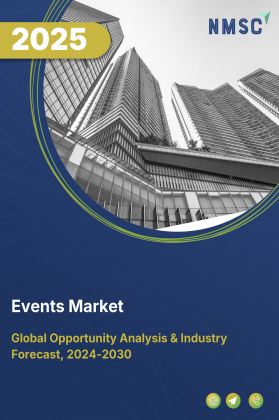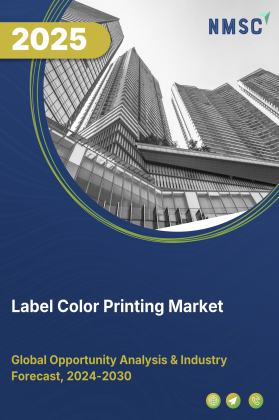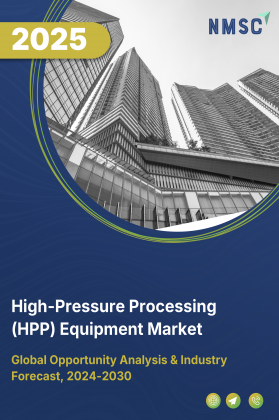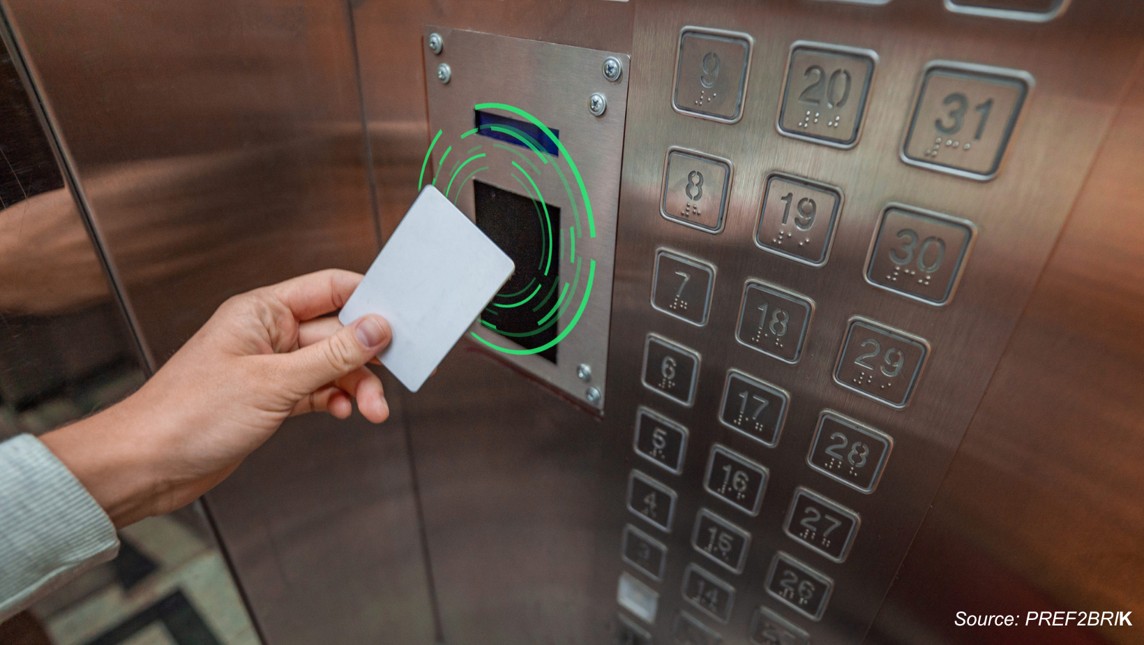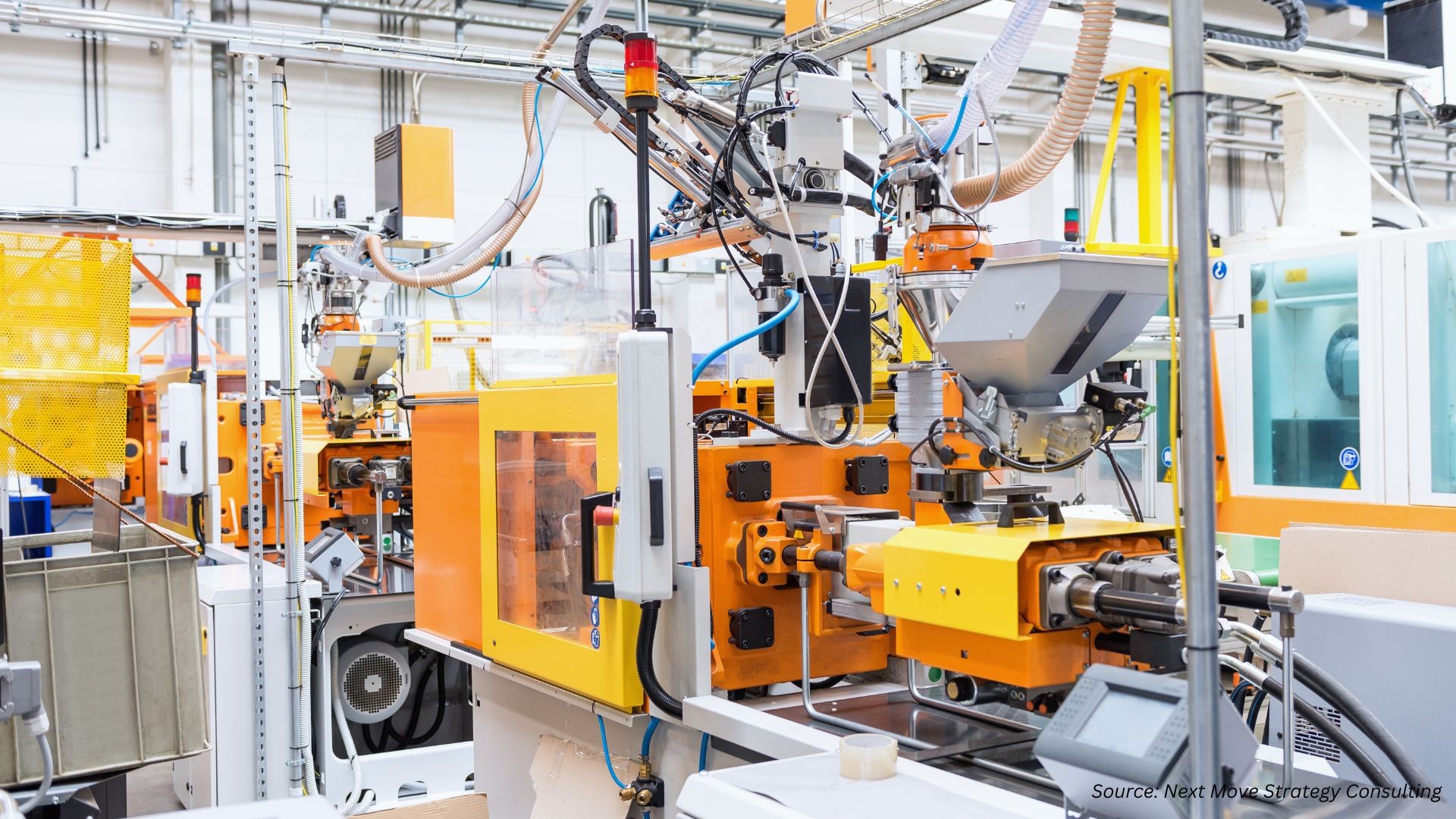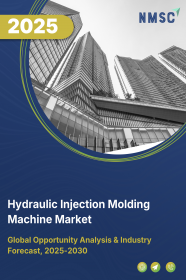
Hydraulic Injection Molding Machine Market by Machine Type (Standard Hydraulic Injection Moulding Machines, Hybrid Injection Moulding Machines, and Servo-Hydraulic Machines), by Product Type (Plastic, Rubber, Metal, Ceramic, and Others), by Clamping Force (Below 200 Tons, 200-500 Tons, and Above 500 Tons), by End-User (Automotive, Packaging, Electronics, Healthcare, Consumer Goods, Toy Making, Building & Construction, and Others) – Global Opportunity Analysis and Industry Forecast 2025-2030
Hydraulic Injection Molding Machine Industry Overview
The global Hydraulic Injection Molding Machine Market size was valued at USD ZZ billion in 2024 and is predicted to reach USD XX billion by the end of 2025. The industry is predicted to reach USD ZZ billion by 2030 with a CAGR of XX% from 2025-2030.
The hydraulic injection molding machine market is driven by the adoption of servo-hydraulic systems, which provide energy savings, precise control, and enhanced performance. The cost-effectiveness and versatility of hydraulic systems, particularly for large or complex parts, also support market demand. Additionally, the growing plastic industry continues to drive hydraulic machine use across sectors like automotive and packaging.
However, competition from electric and hybrid technologies, offering higher precision and energy efficiency, poses a challenge. On the other hand, retrofitting existing hydraulic machines with energy-efficient systems presents a significant growth opportunity, allowing manufacturers to improve performance, reduce energy consumption, and align with sustainable practices.
The Advancing Adoption of Servo-Hydraulic Systems is Fuels the Market Growth
One of the prominent driving factors in the hydraulic injection molding machine market expansion is the continuous evolution of hydraulic technology, particularly the increasing adoption of servo-hydraulic systems. These systems utilize servo motors to control the hydraulic pumps, delivering precise control over pressure and flow and leading to significant energy savings compared to traditional fixed-displacement pump systems.
For instance, servo hydraulics can adjust the oil flow according to the actual requirements of each stage in the injection molding cycle, minimizing wasted energy. This not only reduces operational costs but also aligns with the growing emphasis on sustainability within the plastics processing industry. Several manufacturers are now offering servo-hydraulic injection molding machines that boast improved accuracy, faster cycle times, and reduced noise levels, making them an attractive option for various applications.
The Cost-Effective Strength and Versatility of Hydraulic Systems Drives Demand of the Market
The inherent power and robustness of hydraulic systems coupled with their cost-effectiveness, especially for certain applications. Hydraulic machines are well-regarded for their ability to generate high clamping forces and injection pressures, making them suitable for manufacturing large or complex parts. While electric machines excel in precision and speed for smaller parts, hydraulic machines often present a more economical solution for applications demanding substantial force. This cost-performance balance keeps the demand for Plastic manufacturing equipment steady, particularly in industries where high tonnage and simpler part designs are prevalent. The initial investment for a hydraulic machine can also be lower compared to an all-electric counterpart, making it an attractive option for smaller businesses or those with specific production needs.
The Expanding Plastics Industry Propels Growth of the Market
The fundamental driver underpinning the entire injection molding machine market, including the hydraulic segment, is the consistent and growing demand from the broader plastics processing industry. Plastics are ubiquitous in modern life, used across a vast spectrum of sectors, including automotive, packaging, medical devices, consumer goods, and electronics. As long as the demand for plastic products remains strong, there will be a corresponding need for injection molding machines to manufacture these products. Hydraulic machines, with their versatility and ability to process a wide range of polymers and part sizes, play a crucial role in meeting this demand. The sheer market size and growth potential of the plastics industry inherently drive the demand for various types of injection molding machinery, with hydraulic machines maintaining a significant market share.
Rising Competition from Electric and Hybrid Technologies Limits the Market Share
The hydraulic injection molding machine market is the increasing competition from electric and hybrid injection molding technologies. All-electric machines offer advantages such as higher precision, faster cycle times, lower energy consumption, and reduced noise levels. Hybrid machines attempt to combine the strengths of both hydraulic and electric systems, offering a balance of power and efficiency. As these alternative technologies continue to advance and become more cost-competitive, they pose a growing challenge to the dominance of traditional hydraulic machines in certain segments of the market. Manufacturers need to carefully evaluate their specific application requirements, production volumes, and cost considerations when choosing between hydraulic, electric, or hybrid injection molding technologies, which can limit the overall market share of purely hydraulic machines.
Retrofitting Hydraulic Systems Presents Lucrative Market Trends Opportunity
A significant opportunity exists for industry players in retrofitting existing hydraulic injection molding machines trends with modern, energy-efficient hydraulic systems. Many manufacturers have a substantial installed base of hydraulic machines that are still in good working order. Instead of replacing these entire machines, upgrading their hydraulic systems with technologies like servo pumps can offer a cost-effective way to significantly improve energy efficiency, reduce noise, and enhance performance.
For instance, BOLE introduced the EKW-ECO range, which integrates advanced servo-drive systems to retrofit hydraulic machines, achieving up to 80% energy savings and enhanced precision, aligning with sustainable manufacturing goals. This approach allows manufacturers to leverage their existing investments while adopting more sustainable practices and extending the lifespan of their equipment. The market size for hydraulic retrofitting is substantial, offering a significant avenue for growth and allowing industry players to provide value-added services and solutions to their existing customer base. This also aligns with the growing focus on circular economy principles within the manufacturing sector.
Market Segmentation and Scope of Study
The hydraulic injection molding machine market report is divided on the basis of machine type, product type, clamping force, and end users. On the basis of machine type, the market is divided into standard thermoplastic molding machines, hybrid injection molding machines, and servo-hydraulic machines. On the basis of product type, the market is divided into plastic, rubber, metal, ceramic, and others. On the basis of clamping force, the market is divided into below 200 tons, 200-500 tons, and above 500 tons. On the basis of end users, the market is divided into automotive, packaging, electronics, healthcare, consumer goods, toy making, building & construction, home appliances, and others. Regional breakdown and analysis of each of the aforesaid segments includes regions comprising of Asia-Pacific, North America, Europe, and RoW.
Geographical Analysis
In North America, especially the United States, the manufacturing sector is highly focused on precision and automation. Industries like automotive and medical devices are using advanced tools such as robotics, artificial intelligence (AI), and the Internet of Things (IoT) to boost productivity and quality. For example, collaborative robots and smart systems help make assembly lines more efficient and accurate, reducing production errors by up to 20% in some cases. This reflects the region's commitment to staying competitive through cutting-edge technology, supported by significant investments in automation. According to the U.S. Census Bureau, the U.S. manufacturing sector’s capital expenditures on machinery and equipment reached USD 203.7 billion USD in 2023, underscoring the heavy investment in advanced technologies like robotics and AI to drive efficiency and maintain global competitiveness.
Europe, led by Germany, is known for its focus on innovation and sustainability in manufacturing. Companies like ARBURG are developing hybrid machines that consume up to 30% less energy and resources compared to traditional models, integrating renewable energy sources and recyclable materials. Efforts like the arburgGREENworld initiative, which promotes closed-loop production, show the region’s dedication to eco-friendly production and circular economy practices. This aligns with Europe's goal to reduce environmental impact while maintaining high-quality standards, as evidenced by the European Commission’s Green Deal, which aims to cut greenhouse gas emissions by 55% by 2030 for sustainable industrial transitions.
Asia-Pacific, especially China and India, leads in manufacturing thanks to rapid industrial growth, affordable production, and strong demand for goods. Chinese companies like Haitian and FCS are expanding globally by offering cost-effective and efficient machines, capturing significant market share in injection molding and automation equipment. India is also upgrading its manufacturing with more automation and smart technologies, supported by government initiatives like Make in India. The region’s focus on large-scale, budget-friendly production makes it a major global player, with India’s Ministry of Commerce and Industry reporting that the country’s manufacturing output grew to USD 450 billion USD in 2023, driven by increased automation and foreign direct investment.
In Rest of the World regions like South America and the Middle East, manufacturing is gradually growing, supported by urbanization and access to affordable machines. However, challenges like limited funding and slower technology adoption persist, with some countries relying on imported machinery due to underdeveloped local industries. Even so, there’s rising interest in building local manufacturing capabilities, particularly in Brazil and the UAE, where urban populations are expanding. The International Trade Administration notes that Brazil’s industrial machinery market was valued at USD 12.4 billion USD in 2023, with a projected annual growth rate of 5.8% through 2027, reflecting increased investment in technology and infrastructure to support manufacturing expansion.
Strategic Innovations Adopted by Key Players
Leading players in the global eco-friendly phone case industry are strategically focusing on material innovation and sustainable manufacturing processes to capture a growing market share in a rapidly evolving market. Recent developments showcase the adoption of advanced biodegradable polymers, compostable materials such as wheat straw, bamboo, and cork, and innovative alternatives like mycelium, marking a significant shift away from petroleum-based plastics.
For instance, A Green Co. launched India’s first 100% compostable phone case in 2023, utilizing wheat straw and bio-based polymers, which is certified to meet child safety standards and boasts a 30% lower carbon footprint than traditional plastic cases. Other companies are emphasizing recycled materials, such as post-consumer plastic and ocean-bound waste, alongside closed-loop production systems that minimize resource waste and promote circularity. These efforts align with the broader market trend toward sustainable products, driven by increasing consumer demand for environmentally responsible accessories. According to the U.S. Environmental Protection Agency, sustainable product consumption in the U.S. has grown, with 66% of consumers willing to pay a premium for eco-friendly goods in 2023, bolstering demand for such phone cases.
However, these players face significant challenges in ensuring that eco-friendly alternatives match the durability, drop protection, and aesthetic appeal of conventional phone cases, as biodegradable materials can sometimes be less resilient. Despite these hurdles, substantial growth potential exists, fueled by rising consumer awareness of environmental issues, particularly among millennials and Gen Z, who prioritize sustainability in purchasing decisions. The expanding industry size is supported by the increasing accessibility of eco-friendly phone cases through e-commerce platforms and strategic collaborations with environmentally focused retailers, such as partnerships with brands like Patagonia or REI. Key players are leveraging digital marketing and transparent sustainability certifications, such as B Corp or Cradle to Cradle, to enhance brand reputation and build consumer trust. By addressing durability concerns through R&D and optimizing cost structures, companies are well-positioned to capitalize on this growing market and drive long-term success in the eco-conscious accessory space.
Key Benefits
-
The report provides quantitative analysis and estimations of the hydraulic injection molding machine market from 2025 to 2030, that assists in identifying the prevailing market opportunities.
-
The study comprises a deep-dive analysis of the hydraulic injection molding machine market including the current and future trends to depict prevalent investment pockets in the market.
-
Information related to key drivers, restraints, and opportunities and their impact on the hydraulic injection molding machine market is provided in the report.
-
Competitive analysis of the players, along with their market share is provided in the report.
-
SWOT analysis and Porters Five Forces model is elaborated in the study.
-
Value chain analysis in the market study provides a clear picture of roles of stakeholders
Hydraulic Injection Molding Machine Market Key Segments
By Machine Type
-
Standard Hydraulic Injection Moulding Machines
-
Hybrid Injection Moulding Machines
-
Servo-Hydraulic Machines
By Product Type
-
Plastic
-
Rubber
-
Metal
-
Ceramic
-
Others
By Clamping Force
-
Below 200 Tons
-
200-500 Tons
-
Above 500 Tons
By End-User
-
Automotive
-
Packaging
-
Electronics
-
Healthcare
-
Consumer Goods
-
Toy Making
-
Building & Construction
-
Home Appliances
-
Others
By Region
-
North America
-
The U.S.
-
Canada
-
Mexico
-
-
Europe
-
The UK
-
Germany
-
France
-
Italy
-
Spain
-
Denmark
-
Netherlands
-
Finland
-
Sweden
-
Norway
-
Russia
-
Rest of Europe
-
-
Asia-Pacific
-
China
-
Japan
-
India
-
South Korea
-
Australia
-
Indonesia
-
Singapore
-
Taiwan
-
Thailand
-
Rest of Asia-Pacific
-
-
Rest of the World
-
Latin America
-
Middle East
-
Africa
-
Key Players
-
ARBURG GmbH + Co KG
-
N. K. Hydraulic Industries
-
Shibaura Machine India Pvt. Ltd.
-
Sumitomo Heavy Industries, Ltd.
-
Chen Hsong Holdings Limited
-
Milacron, LLC
-
Husky Technologies
-
Nissei Plastic Industrial Co. Ltd.
-
Rodon Group
-
Basilius
-
Ningbo Daoben Machinery Co., Ltd.
-
Sahkar Industries
-
Daikin Industries, Ltd.
REPORT SCOPE AND SEGMENTATION:
|
Parameters |
Details |
|
Market Size in 2024 |
USD XX Billion |
|
Revenue Forecast in 2030 |
USD XX Billion |
|
Growth Rate |
CAGR of XX% from 2025 to 2030 |
|
Analysis Period |
2024–2030 |
|
Base Year Considered |
2024 |
|
Forecast Period |
2025–2030 |
|
Market Size Estimation |
Billion (USD) |
|
Growth Factors |
|
|
Countries Covered |
28 |
|
Companies Profiled |
15 |
|
Market Share |
Available for 10 companies |
|
Customization Scope |
Free customization (equivalent to up to 80 working hours of analysts) after purchase. Addition or alteration to country, regional, and segment scope. |
|
Pricing and Purchase Options |
Avail customized purchase options to meet your exact research needs. |




















 Speak to Our Analyst
Speak to Our Analyst



